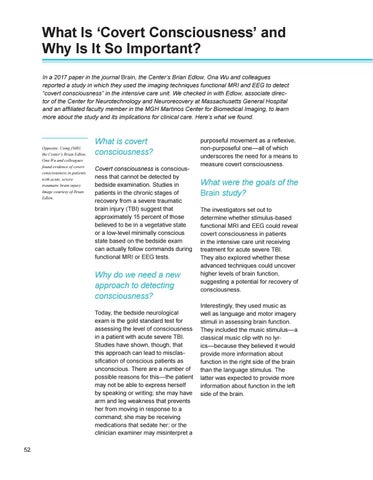What Is ‘Covert Consciousness’ and Why Is It So Important? In a 2017 paper in the journal Brain, the Center’s Brian Edlow, Ona Wu and colleagues reported a study in which they used the imaging techniques functional MRI and EEG to detect “covert consciousness” in the intensive care unit. We checked in with Edlow, associate director of the Center for Neurotechnology and Neurorecovery at Massachusetts General Hospital and an affiliated faculty member in the MGH Martinos Center for Biomedical Imaging, to learn more about the study and its implications for clinical care. Here’s what we found.
Opposite: Using fMRI, the Center’s Brian Edlow, Ona Wu and colleagues found evidence of covert consciousness in patients with acute, severe traumatic brain injury Image courtesy of Brian Edlow.
What is covert consciousness? Covert consciousness is consciousness that cannot be detected by bedside examination. Studies in patients in the chronic stages of recovery from a severe traumatic brain injury (TBI) suggest that approximately 15 percent of those believed to be in a vegetative state or a low-level minimally conscious state based on the bedside exam can actually follow commands during functional MRI or EEG tests.
Why do we need a new approach to detecting consciousness? Today, the bedside neurological exam is the gold standard test for assessing the level of consciousness in a patient with acute severe TBI. Studies have shown, though, that this approach can lead to misclassification of conscious patients as unconscious. There are a number of possible reasons for this—the patient may not be able to express herself by speaking or writing; she may have arm and leg weakness that prevents her from moving in response to a command; she may be receiving medications that sedate her; or the clinician examiner may misinterpret a 52
purposeful movement as a reflexive, non-purposeful one—all of which underscores the need for a means to measure covert consciousness.
What were the goals of the Brain study? The investigators set out to determine whether stimulus-based functional MRI and EEG could reveal covert consciousness in patients in the intensive care unit receiving treatment for acute severe TBI. They also explored whether these advanced techniques could uncover higher levels of brain function, suggesting a potential for recovery of consciousness. Interestingly, they used music as well as language and motor imagery stimuli in assessing brain function. They included the music stimulus—a classical music clip with no lyrics—because they believed it would provide more information about function in the right side of the brain than the language stimulus. The latter was expected to provide more information about function in the left side of the brain.










































































